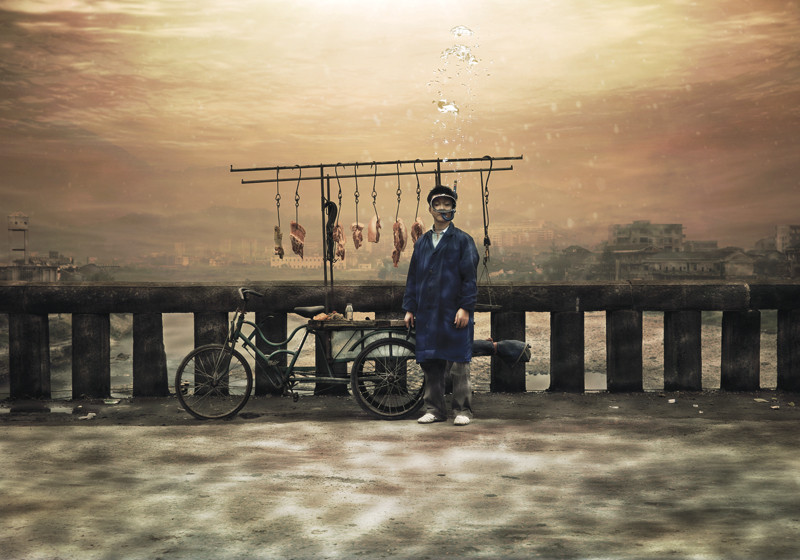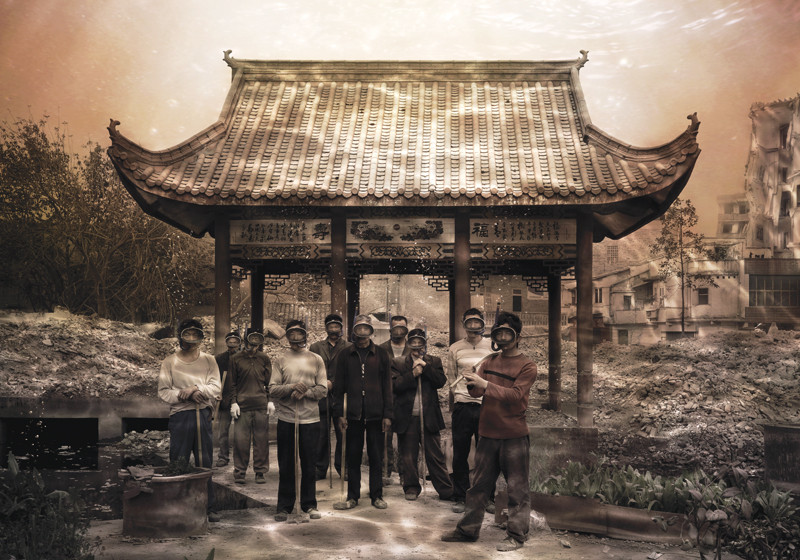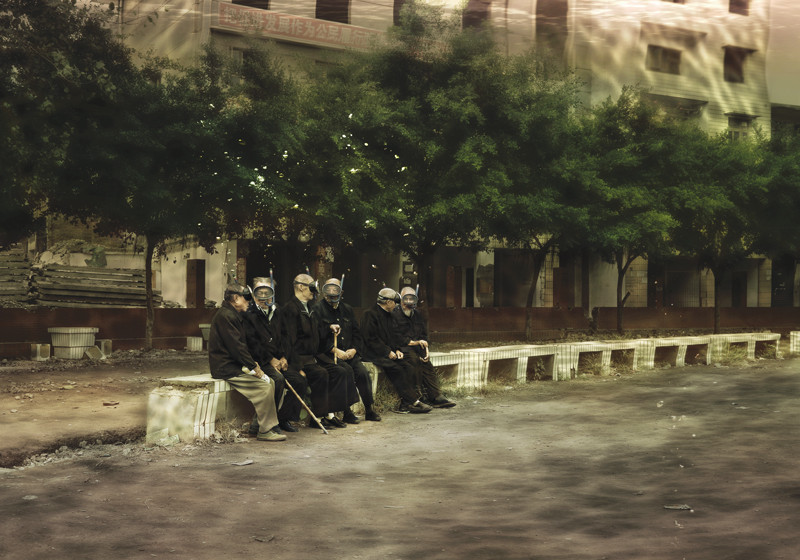by Sylvain Campeau
Have you heard of Kaixian? It’s a charming tourist site if ever there was one! But to visit, you’ll have to replay it, since the town is now under the waters of the Yangzi. If you want to pay a virtual visit, what remains are the images of a young Chinese photographer, Yang Yi, who was born there. However, you will have to understand something. Apparently, these images were taken underwater. The air bubbles floating up from the figures in the pictures provide ample proof.
The result is aberrant, disturbing scenes, all issuing from imagination and anxious dreams. For Yang Yi dreamt these scenes. He saw them first in his sleep, and the experience provoked such anxiety that he felt suffocated. So he decided to return, camera in hand, to the town where he was born during its last three years of existence – to places imbued with the images and memories of his youth. He was thus able to perceive the city’s state of advanced decrepitude, as it was already succumbing to the gradual destruction undertaken by the authorities and the population; a slogan, of which he reports the existence and the wording, said, “Let us destroy half the city in one hundred days.” To this commanded enthusiasm, forced (as we can well guess) upon the city’s inhabitants, Yang Yi wanted to respond with this particular photographic mission, one that was utterly opposed to the mission of the authorities pursuing the needs of modernity and electric megaproduction. In fact, the authorities opposed Yang Yi and all those like him, who were nostalgic for the 160 historical and archaeological sites that disappeared due to the Three Gorges dam, 2,335 metres long and about 100 metres high, with an electrical production capacity of 84.7 TWh per year. Who were they to oppose progress and a reservoir with an area of 1,084 km², the 1.2 million (or more) people displaced with no form of assistance afforded to them, the enormous number of people who died on the site in ten years, and the fifteen cities and 116 villages submerged? And how little the 600 km2 of flooded farmland and forests were worth.
Images of the Engulfment
On this sea of gigantic numbers, the scope of this triumphant industrialization and industrial deployment, Yang Yi’s project, Uprooted, barely floats. If it had not been about images of places soon to be engulfed, this would have been just another effort at documentation, and it would have stopped there, with these numbers, with our inner indignation, with what the Chinese writer called the “ridiculous and detrimental farce that will haunt the Chinese leaders.” Yang Yi decided not to act in enraged denunciation. Nor did he opt for the ethical upheaval of an Edward Burtynsky, for example, who dresses up his images of devastation, ship cemeteries, dust and debris of forgotten mines, and abandoned sites of industrial extraction, draping them in luxuriant colours as one would bucolic landscapes, confronting viewers with deleterious, noxious beauty, under the cover of a romantic aesthetic that he skilfully perverts. Incidentally, Burtynsky also took on the task of documenting through photographic images the changing landscape of sites altered by this monstrous structure. He did this to preserve the traces of this damage, and he did so in the style of a global imagistic inquiry that went from one place to another – from the site and gradual construction of the dam, in its preparatory stages, to human and natural habitats in collapse, prematurely forced into ruin.
This indifference to the foregone sad fate seems to stand for our own apathy and be a reprimand to all those who have let it go ahead.
Villages and Days: Walking Remains
But this is quite distant from the task that Yang Yi took on. First, he had to work fast for, from one trip to the next, everything was metamorphosing rapidly. He visited sites over a three-year period, the second trip on a boat on the Yangzi and the third at top speed, with a sense of urgency. The resulting images have a good dose of timeless desire in the sense that they depict an apparently imaginary version. Of course, these were the components of soon-to-be-submerged cities. Sections of walls, rubble, disembowelled streets and houses are those that we will see in this version of the future. But elsewhere, this version is fantastic. We know, we feel, that people we see cannot be there, cannot live there. The presence of masked pedestrians and inhabitants, feet rooted to the ground as if they were on land, emphasizes the impossibility. They are there, some of them bare-chested like true divers, with some vestige in their hands – a street number perhaps – of the life that they had led. These images are dramatic, the images of an imagined return, a melancholic visit, a desperate attempt at habitation. Others are more poignant, those of people who decide in a way to shrug off inevitability. Parents face the camera, wanting to have their picture taken as a souvenir; beside them is one of their children, dressed in bright colours, out of place in the squalor, the mud-coloured water, and the greyish tedium of the debris. Yet others act as if nothing is happening. They keep on with their usual activities. Here, they’re playing cards. There, a barber cuts a customer’s hair. Someone plays hopscotch; someone else does his morning Tai Chi. This indifference to the foregone sad fate seems to stand for our own apathy and be a reprimand to all those who have let it go ahead. And there are many more images in which the irony is palpable, such as the one of the man who seems to be floating at the bottom of a swimming pool, and another, in a boat on a stretch of water, bubbles escaping from his mask and rising toward the new surface.
From these buried villages, Yang Yi has made immemorial sites. He has given them an aura. His work creates a fantastic version of what they will soon be. It is as if the commemorative properties of these images come to form an alliance with a transfiguration of the site by the imagination, as if the memorial properties of photography took these images in advance. They are in fact the revealing of an imaginary prospecting that leads the sites – forces them, one might say – to be a memory in advance, a souvenir in the process of becoming. An announced memory. Mythical by anticipation. No doubt, this double aspect on which they play – the prediction of a reminiscence – is what is memorable about them. With them, Yang Yi creates, in advance, a memory to which he wants to be connected, in which he also wants to live, so he does not disappear in the destroyed framework of these towns and cities that once were.
In an article by Brigitte Duzan published in Ici, la Chine, Yang Yi says,
“In 2009, [Kaixian] will be the last city to be evacuated and submerged by the water of the dam, which will uproot its inhabitants forever. Kaixian and the eighteen hundred years of history of the city of my childhood will be crossed off the map. I was born there thirty-six years ago. On that day, I will awake submerged, too.”
Translated by Käthe Roth
Yang Yi was born in Kaixian (Chongqing Province, China) in 1971. He worked as a graphic designer from 1993 to 2000 in Chengdu, where he co-founded the Lan Se Fei Yang advertising agency in 2001. His work has been exhibited in China, and was recently included in a Make Art Public (MAP) photo exhibition presented on bus shelters in some fifteen cities across Canada and Mexico. Yang is represented by Paris-Beijing photo gallery, in Beijing.
Sylvain Campeau has contributed to a large number of Canadian and international publications, such as Ciel variable, ETC, Photovision, and Papal Alpha. As an independent curator, he has also mounted over thirty exhibitions in Canada and abroad. He is the author of an essay entitled Chambre obscure : photographie et installation and of four books of poetry.






